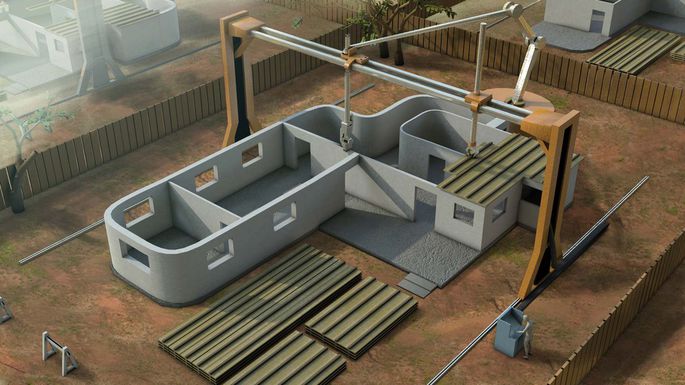While 3D printing has been around for over 30 years, in the eyes of the general public, this technique has a futuristic and fascinating side. Even today, this field continues to evolve thanks to specialized companies and a community of enthusiasts. Let's take a look at the history of 3D technology, from its beginnings to today.

The birth of 3D printing
The crazy idea of finding a way to create and duplicate objects using a printer is not new. In 1972, Hergé had already imagined a three-dimensional photocopier. It made it possible to reproduce objects and works of art identically. A not so far-fetched idea after all!
In 1984, the very first patent on "additive manufacturing" was filed by three Frenchmen: Jean-Claude André, Olivier de Witte, and Alain le Méhauté, for the company CILAS ALCATEL. Cock-a-doodle-doo!
However, history will remember the name of the American Chuck Hull who, a few weeks later, patented the stereolithography technique (SLA for StereoLithography Apparatus). This patent is at the origin of the name of the extension of the .stl printing file of the giant 3D Systems. It is worth noting that engineer Chuck Hull is not a layman: he is the author of some 60 patents in the field of rapid prototyping.
In 1987, the process of selective laser sintering (or SLS - Sintering Laser System) was invented by the company DTM corp. This new additive manufacturing process consists in manufacturing an object, layer by layer, on the basis of polymer powders, by laser sintering. Rapid prototyping becomes a commercial reality!
In 1988, the American company Stratasys launched a new technology on the market that is also based on the deposition of layers. It is the FDM process(Fused Deposition Modeling ). This technique is still used today for domestic printers.
Since 1995, 3D printing has taken a new step with DMLS(Direct Metal Laser Sintering). This technology corresponds to the already known process of selective laser sintering but this time on the basis of metallic powders with a very powerful laser.
The 2000s or the great boom of innovations
In 2005, ZCorporation launched the first color printer. In the same way as a 2D four-color printer, the printing is done on the height in successive layers with a mineral type material aggregated by a glue binder.
2005 is also theyear of birth of 3D Prod, at a time when the professional 3D printing market was in its infancy. The company initially focused on laser powder sintering, which at the time offered interesting flexibility in the context of a business start-up: it was possible to produce both plastic and metal parts with a single piece of equipment. Since then, it has increased its capacities and the range of technologies offered.
Open source 3D printing took an exclusive turn in 2006 with Dr. Adrian Browyer (professor of mechanical engineering at theUniversity of Bath in the UK) and his RepRap project. The idea behind this project is to be able to build a 3D printer yourself using molten wire deposition technology. This is the beginning of the DIY movement.
10 years later, the company Carbon3D brings to the market a new revolutionary technology: CLIP. It allows to multiply by seven the speed in 3D printing. This by using resin, light and oxygen to polymerize the object:
Today, the giants of 2D printing also want a piece of the pie. Hewlett Packard (HP) is positioning itself in professional 3D printers with its patented Multijet Fusion technology. HP is mixing multi-color printing and sintering technologies, which is a revolution in the industry.
Moreover, in 2017, 3D Prod becomes the referent site for HP in France. For 6 months, the French company became the first and only professional 3D printer on our territory to use the technology created by HP.
More and more extraordinary cases of application
Very quickly, researchers and engineers are exploiting the possibilities offered by 3D printers, particularly in the medical field.
In 1999, the first prosthesis was implanted in a human being. It was a prosthesis that accompanied the enlargement of a patient's bladder. The constraints were significant: to create an "object" adapted to the physiognomy of a patient and to avoid the risks of rejection. To do this, the part was coated with the patient's cells.
In 2002, academics at the Wake Forest Institute for Regenerative Medicine recreated a functional kidney. Capable of filtering blood and diluting urine, it was grafted onto animals and opened the way to the creation of organs and tissues for medical purposes.
But the progress does not stop there! In 2012, a lower jaw prosthesis was placed on an octogenarian.
Today, it is possible to create upper and lower limb prostheses adapted to the morphology of the patients. They can even be customized to infinity.
Since 2010, 3D printing has opened up to new fields. Former President Barack Obama understood that 3D printing is the "next industrial revolution". And he was not wrong, because it is common to consider 3D printing as the fourth industrial revolution.
In 2011, engineers from theUniversity of Southampton manage to create an unmanned aircraft(Sulsa) in one week with the SLS. It has a wingspan of almost 2 m and is propelled at 160km/h by an electric motor.
The same year, it is the Kor Ecologic company which presents Urbee. A car whose body is totally composed of parts printed with 3D printers. Moreover, Urbee is "eco-friendly".
That same year, it became possible to print objects in gold or silver. The goal is to free ourselves from the constraints of professionals and to offer jewelry that is more and more unique and personalized.
The following year, food 3D printing arrived and made the buzz. One thinks of the 3D printing of sugar by the American company The Sugar Lab, and the first chocolate 3D printer by the British firm Choc Edge.
In 2014, technological evolution is taking on real estate. Chinese company Win Su is offering to build low-cost 3D printed homes.
What about the future?
3D printing is a far-reaching technical and technological innovation with infinite applications. In the field of industrial production, 3D printing offers significant prospects. These include reducing production time and customizing products.
It is estimated that the demand for this technology will continue to grow for years to come. In 2015, theGartner Institute study predicted the marketing of more than 200,000 3D printers for a global turnover estimated at more than 1.6 billion dollars. Successful bet!
And it continues! According to these forecasts, in 2018, there will be more than 3 million printers sold, for an estimated turnover of nearly 13.6 billion dollars.
In France, during his tenure as Minister of the Economy in 2015, Emmanuel Macron had announced his desire to make the French industrial environment "an industry of the future." This would involve the massive use of new technologies like 3D printing. France has begun to democratize this activity. Many companies specializing in the manufacture of 3D printers are flourishing, as well as small start-ups dedicated to the production of products. However, France still lags behind, coming in seventh place when comparing the number of 3D printers.

